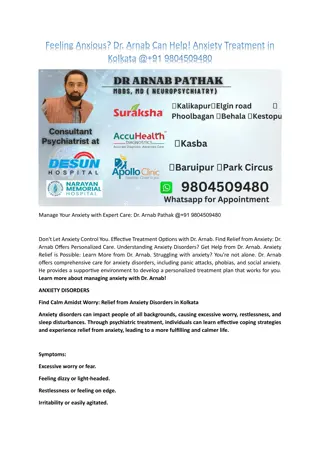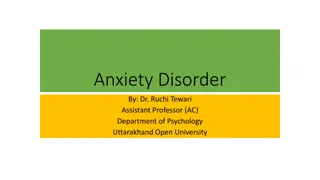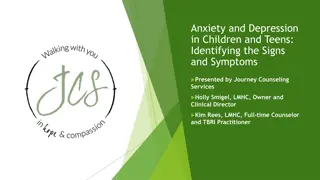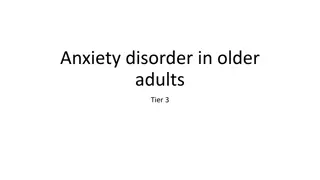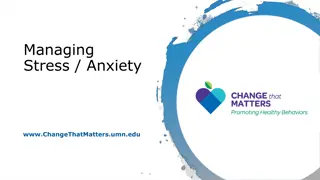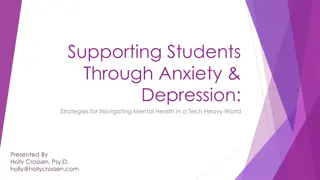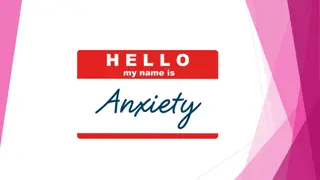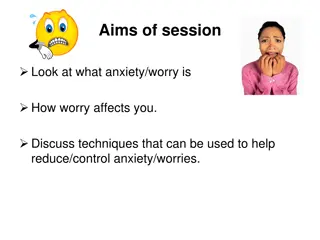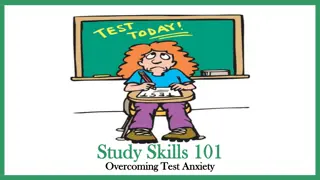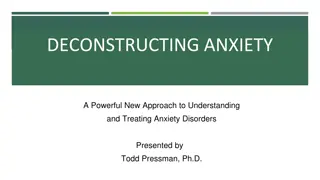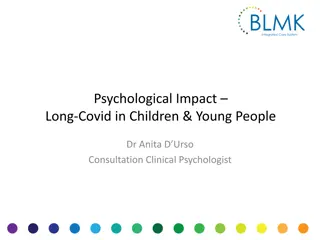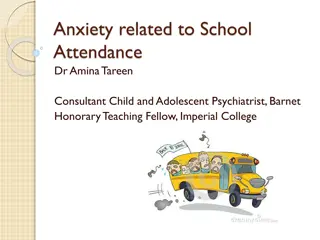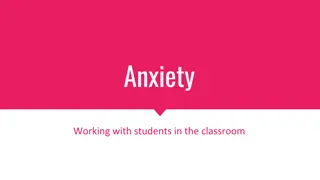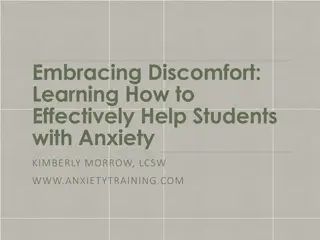Understanding Anxiety in Children: Symptoms, Types, and Support
Anxiety in children is a common experience but can become problematic if persistent. Learn about the different types of anxiety disorders, symptoms, and how to support children experiencing anxiety. Recognize negative symptoms, understand where it hurts, and find ways to help your child cope effectively with anxiety.
Download Presentation

Please find below an Image/Link to download the presentation.
The content on the website is provided AS IS for your information and personal use only. It may not be sold, licensed, or shared on other websites without obtaining consent from the author. Download presentation by click this link. If you encounter any issues during the download, it is possible that the publisher has removed the file from their server.
E N D
Presentation Transcript
Welcome & Welcome & Introductions Introductions KEDDIE BAILEY: KEDDIE BAILEY: PARENT SUPPORT CO PARENT SUPPORT CO- -ORDINATOR & HOPE MENTOR & HOPE MENTOR ORDINATOR
Anxiety in children and how to support
Anxiety is a feeling of worry or fear that is experienced as a combination of physical sensations, thoughts and feelings. All children and young people feel worried sometimes, and this is a normal part of growing up. At certain points, such as on their first day of school or before an exam, young people may become more worried, but will soon be able to calm down and feel better. WHAT IS WHAT IS ANXIETY ANXIETY Anxiety can become a problem when a child or young person feels stuck in it, or when it feels like an overwhelming, distressing or unmanageable experience. If this kind of worrying goes on for a long time, it can leave a young person feeling exhausted and isolated and limit the things they feel able to do.
7 types of Anxiety Disorders 7 types of Anxiety Disorders: Specific Phobias: dark, vomiting needles Generalised Anxiety Disorder: intense worrying most days Complex Phobias: social phobia agoraphobia Panic Attacks Obsessive Compulsive Disorder Separation Anxiety Health Anxiety
Where does it hurt ? Acitivity What happens to our body ? How to Help How to Help your child your child - - Younger children may not easily recognise that what they are feeling is worry, fear or anxiety. But they may be able to say they feel upset or sad and they may describe physical feelings.
Negative Symptoms: Negative Symptoms: Cognitive Memory and concentration problems, obsessive thoughts, negative thoughts about yourself, what if and worst case scenario thoughts, thoughts about bad things happening, blowing things out of proportion, thoughts that things are worse than they actually are, self- doubting, self-blaming Physical Sweating, headaches, nausea, choking sensation, lump in throat, feeling hot or cold, shortness of breath/cant catch breath, heart racing, palpatations, chest tightness or pain, stomach ache/butterflies, tiredness, muscle aches, sleep disturbance, tingling of lips or teeth grinding
Negative Symptoms: Negative Symptoms: Emotional Behavioural Worry, feeling on edge, panic, nervousness, dread, fear, restlessness, tension, distress, feeling worthless, low in confidence, poor self-esteem, feeling under pressure and overwhelmed, anger, irritability, confusion, loss of motivation/pleasure/interest, hyper- sensitivity to things, self criticism and doubt, defensiveness. Avoidance, following rituals or routines, putting off doing things, doing things to get people s attention, seeking reassurance, checking for signs of danger, acting irritably or aggressively, hiding away from people, getting annoyed with self, taking out your feelings on others, stuttering or stammering, pacing, being unable to sit still, not finishing things, crying.
Starve our anxiety Feed our anxiety Think realistically/rationally Think negatively Recognise our thoughts are obsessive Blow situation out of proportion Keep our expectations realistic Anxious physical symptoms appear Build self esteem, confidence and positivity Behaviours become unconstructive The more unconstructive our behaviours, the more negative and out of proportion thoughts follow We perpetuate the cycle We break the cycle
Find the Triggers Find the Triggers Being away from family The dark School Friendships Bullying Change Family Problems Being alone Food Storms Death School work and exams Friendships/relationships Crowded places Speaking in groups Bullying Leaving the house Peer pressure Yours or their health What other people think of them World news Future Their appearance
What if I cant Negative thoughts about yourself Identify the Identify the thought thought patterns patterns - - Worse Case Scenario Likelihood exaggeration Self-blaming Jumping to conclusions Things are worse than they are Unrealistic thoughts about situations
Upset Worthless Lonely Nervous Worried Restless Identify the Identify the feelings feelings - - Panicky Trapped Angry Overwhelmed Confused Agitated Irritable Isolation
Negative Thinking Glasses - Start with the thoughts ! Magnifying Glasses: everything seems bigger, more important, more dangerous. My life will be over if I don t pass this test, my parents will hate me Make Believe Glasses: imagining things to be true I don t fit in, I don t look like anyone else, I don t want to go out Fortune Telling Glasses: Bad things will happen, worst case scenario thinking Year 7 will be awful, I wont make new friends, I wont want to go What If Glasses: what if this bad thing happens, what if that bad thing happens My friend has been sick, what If Im ill now, what if I'm sick in school Mind Reading Glasses: other people thinking negative thoughts about you My teacher looks at me funny, they don t like me and think I'm stupid Doom & Gloom Glasses: seeing the worst in everything, focus on the negative everything will go wrong I'm rubbish, I never get picked for football so why should I try
We can find it hard to: Concentrate, focus and pay attention Retrieve information from our memory Understand information: comprehension Follow processes and sequences Gather our thoughts into a logical and clear format Put our thoughts down on paper or say them our loud in a reasoned and clear way Frequently thinking negatively and unrealistically about learning, school work and tests causes other cognitive symptoms we can often feel like our minds have gone blank.
Is this thought helpful right now Accepting our thoughts are only thoughts: Which glasses am I wearing What am I thinking ?? Is my thought based on fact Have I evidence to back up this thought Ditching the Thinking Glasses What is the worst thing that could happen, is it likely? Can I think more realistically, based on fact What is more likely to happen
Test Stress Box Test Stress Box MY UNREALISTIC EXPECTATIONS ABOUT WORK, REVISION AND EXAMS ALTERNATIVE, REALISTIC EXPECTATIONS It will be too hard, I wont know the answers I've revised, I will know at least some of it ! I m going to panic and get it all wrong I know how to self care, I did well in practice, I can manage this I ll just fail, I m trying, but I ll fail Everyone knows I'm working hard, they know I ll do my best and that is enough
From an NSPCC study, young people said they didnt talk to their parents because: They wouldn t understand They would over-react They would become worried or upset They would not be believed In a calm moment, talk with your child about their anxiety. Ask them what it feels like in their mind and body, and what things make them feel that way. It can be tempting to dismiss their worries because you want to reassure them, but it s important to empathise with their experience and validate their feelings. To discuss their worries with someone they needed: To be listened to To know that person could help Not to be judged Not to be told off Not to have that person take control
In the moment In the moment To relax Walk or step outside to get some fresh air Exercise or physical activity Breathe deeply Visualise Listen to music Colour or draw Soothe box To distract Watch a film Play a game Activity with family Read Meet or speak to friends Do something physical
It might feel like the smallest thing causes our bucket to overspill
Give permission Connect Emotion Coaching Label Empathy and understanding Validate Problem solve
Challenging the thoughts Challenging the thoughts - -
Breaking Breaking it down it down
Make a self soothing box
Self Care Self Care We need to manage our own anxieties in order to react calmly, model behaviour and emotional responses
PROVIDES INFORMATION, SUPPORT AND ADVICE FOR ANYONE STRUGGLING WITH ANXIETY. LIVE CHAT SERVICE AVAILABLE. Anxiety UK Anxiety UK PHONE: 03444 775 774 TEXT: 07537 416 905 EMAIL: SUPPORT@ANXIETYUK.ORG.UK OPENING TIMES: 9.30AM-5.30PM, MONDAY-FRIDAY
IF YOU ARE A PARENT OR CARER WORRIED ABOUT YOUR CHILD SPEAK TO OUR EXPERTS AT THE PARENTS HELPLINE CALL FOR FREE ON 0808 802 5544 (9:30AM - 4PM, MON - FRI). EMAIL USING OUR PARENTS HELPLINE CONTACT FORM. USE OUR LIVE PARENTS WEBCHAT SERVICE (9:30AM - 4PM, MON FRI) Young Minds Young Minds https://www.youn gminds.org.uk/par ent/parents-a-z- mental-health- guide/ Pooky Knightsmith Mental Health YouTube
https://www.mpft.nhs.uk/services/health-visiting-and-school- nursing/staffordshire-clinics/what-we-offer https://camhs.mpft.nhs.uk/south-staffordshire/self-referral- mental-health-support https://www.staffordshire-ewb.actionforchildren.org.uk/
APPS | CAMHS Resources (camhs-resources.co.uk) Wellbeing apps for kids | Internet Matters



